Structural Evolution of Polyaluminocarbosilane during the Polymer–Ceramic Conversion Process
Abstract
1. Introduction
2. Experimental
2.1. Synthesis and Pyrolysis of PACS
2.2. Characterization
3. Results and Discussion
3.1. Molecular Structure Changes and TG Analysis
3.2. Structural Form Changes for the Elements of Si, C, and Al
3.3. Chemical Position and Crystal Structure Changes
4. Conclusions
Author Contributions
Funding
Institutional Review Board Statement
Informed Consent Statement
Data Availability Statement
Conflicts of Interest
References
- Yajima, S.; Hayashi, J.; Omori, M.; Okamur, K. Development of a silicon carbide fibre with high tensile strength. Nature 1976, 261, 683–685. [Google Scholar] [CrossRef]
- Ishikawa, T.; Kohtoku, Y.; Kumagawa, K.; Yamamura, T.; Nagasawa, T. High-strength alkali-resistant sintered SiC fibre stable to 2200 °C. Nature 1998, 391, 773–775. [Google Scholar] [CrossRef]
- Riedel, R.; Kleebe, H.; Schönfelder, H.; Aldinger, F. A covalent micro/nano- composite resistant to high-temperature oxidation. Nature 1995, 374, 526–528. [Google Scholar] [CrossRef]
- Chen, Y.; Li, C.; Wang, Y.; Zhang, Q.; Xu, C.; Wei, B.; An, L. Self-assembled carbon-silicon carbonitride nano-composites: High-performance anode materials for li-thium-ion batteries. J. Mater. Chem. 2011, 21, 18186–18190. [Google Scholar] [CrossRef]
- Bernard, S.; Miele, P. ChemInform abstract: Ordered mesoporous polymer-derived ceramics and their processing into hierarchically porous boron nitride and silico-boron carbonitride monoliths. Cheminform 2014, 38, 1923–1931. [Google Scholar] [CrossRef]
- Zhao, R.; Shao, G.; Cao, Y.; An, L.; Xu, C. Temperature sensor made of polymer-derived ceramics for high-temperature applications. Sens. Actuat. A—Phys. 2016, 219, 58–64. [Google Scholar] [CrossRef]
- Cao, F.; Kim, D.; Li, X.; Feng, C.; Song, Y. Synthesis of polyaluminocarbosilane and reaction mechanism study. J. Appl. Polym. Sci. 2002, 85, 2787–2792. [Google Scholar] [CrossRef]
- Gou, Y.; Wang, H.; Jian, K.; Wang, Y.; Wang, J.; Song, Y.; Xie, Z. Facile synthesis of melt-spinnable polyaluminocarbosilane using low-softening-point polycarbosilane for Si-C-Al-O fibers. J. Mater. Sci. 2016, 51, 8240–8249. [Google Scholar] [CrossRef]
- Yu, Y.; Li, X.; Cao, F. Synthesis and characterization of polyaluminocarbosilane. J. Mater. Sci. Lett. 2005, 40, 2093–2095. [Google Scholar] [CrossRef]
- He, G.; Chen, J.; Chen, L.; Xia, H.; Zhang, L. Method for preparing polyaluminocarbosilane. J. Appl. Polym. Sci. 2009, 113, 3725–3731. [Google Scholar] [CrossRef]
- Xie, Z.; Gou, Y. Polyaluminocarbosilane as precursor for aluminum-containing SiC fiber from oxygen-free sources. Ceram. Int. 2016, 42, 10439–10443. [Google Scholar] [CrossRef]
- Duan, Y.; Mo, G.; Chen, H.; Liang, Y.; Cui, Z.; Yang, X.; Zhu, S.; Li, Z.; He, L.; Huang, Q. Synthesis of polyaluminocarbosilane with low branching extent using liquid polysilacarbosilane and aluminum acetylacetonate by high-pressure method. Appl. Organomet. Chem. 2019, 33, e4720. [Google Scholar]
- Yang, J.; Cheng, X.; Yu, Y.; Zhang, Y. Quantitative determinations in the molecular structures of polyaluminocarbosilane. Polymer 2011, 52, 3811–3818. [Google Scholar] [CrossRef]
- Duan, Y.; Mo, G.; Huangfu, Z.; Liang, Y.; Cui, Z.; He, L.; Huang, Z.; Chai, Z.; Huang, Q. Effects of aluminium content on the molecular structure and properties of polyaluminocarbosilane for SiC fibre fabrication. Ceram. Int. 2019, 45, 16380–16386. [Google Scholar] [CrossRef]
- An, L.; Wang, Y.; Bharadwaj, L.; Zhang, L.; Fan, Y.; Jiang, D.; Sohn, Y.; Desai, V.; Kapat, J.; Chow, L. Silicoaluminum carbonitride with anomalously high resistance to oxidation and hot corrosion. Adv. Eng. Mater. 2004, 6, 337–340. [Google Scholar] [CrossRef]
- Wang, Y.; An, L.; Fan, Y.; Zhang, L.; Burton, S.; Gan, Z. Oxidation of polymer-derived SiAlCN ceramics. J. Am. Ceram. Soc. 2005, 88, 3075–3080. [Google Scholar] [CrossRef]
- Babonneau, F.; Sorarú, G.; Thorne, K.; Mackenzie, J. Chemical characterization of Si-Al-C-O precursor and its pyrolysis. J. Am. Ceram. Soc. 1991, 74, 1725–1728. [Google Scholar] [CrossRef]
- Li, X.; Edirisinghe, M. Evolution of the ceramic structure during thermal degradation of a Si-Al-C-O precursor. Chem. Mater. 2004, 16, 1111–1119. [Google Scholar] [CrossRef]
- Zheng, C.; Li, X.; Wang, H.; Zhao, D.; Hu, T. Evolution of crystallization and its effects on properties during pyrolysis of Si-Al-C-(O) precursor fibers. J. Mater. Sci. 2008, 43, 3314–3319. [Google Scholar] [CrossRef]
- Chen, L.; Zhang, L.; Cai, Z.; Yu, Y.; Gu, H.; Zhang, L. Effects of oxidation curing and sintering additives on the formation of polymer-derived near-stoichiometric silicon carbide fibers. J. Am. Ceram. Soc. 2008, 91, 428–436. [Google Scholar] [CrossRef]
- Mah, T.; Hecht, N.; Mccullum, J.; Hoenigman, K.H.; Katz, A.; Lipsitt, H. Thermal stability of SiC fibres (Nicalon). J. Mater. Sci. 1984, 19, 1191–1201. [Google Scholar] [CrossRef]
- Ichikawa, H. Polymer-derived ceramic fibers, Annu. Rev. Mater. Res. 2016, 46, 6.1–6.22. [Google Scholar] [CrossRef]
- Yu, Y.; Tang, X.; Li, X. Characterization and microstructural evolution of SiC(OAl) fibers to SiC(Al) fibers derived from aluminum-containing polycarbosilane, Compos. Sci. Technol. 2008, 68, 1697–1703. [Google Scholar]
- Yao, R.; Feng, Z.; Chen, L.; Zhang, Y. Effects of oxidation curing and Al atoms on the formation of near-stoichiometric freestanding SiC(Al) films derived from polyaluminocarbosilane (PACS). J. Eur. Ceram. Soc. 2013, 33, 1675–1683. [Google Scholar] [CrossRef]
- Hesegawa, Y.; Okamura, K. Synthesis of continuous silicon carbide fibre, Part 3 Pyrolysis process of polycarbosilane and structure of the products. J. Mater. Sci. 1983, 18, 3633–3648. [Google Scholar] [CrossRef]
- Babonneau, F.; Sorarù, G.D.; Mackenzie, J.D. 29Si MAS-NMR investigation of the conversion process of a polytitanocarbosilane into SiC-TiC ceramics. J. Mater. Sci. 1990, 25, 3664–3670. [Google Scholar] [CrossRef]
- Sorarù, G.D.; Babonneau, F.; Mackenzie, J.D. Structural evolutions from polycarbosilane to SiC ceramic. J. Mater. Sci. 1990, 25, 3886–3893. [Google Scholar] [CrossRef]
- Ly, H.; Taylor, R.; Day, R.; Heatley, F. Conversion of polycarbosilane (PCS) to SiC-based ceramic Part II. Pyrolysis and characterization. J. Mater. Sci. 2001, 36, 4045–4057. [Google Scholar]
- Porte, L.; Sartre, A. Evidence for a silicon oxycarbide phase in the Nicalon silicon carbide fibre. J. Mater. Sci. 1989, 24, 271–275. [Google Scholar] [CrossRef]
- Laffon, C.; Flank, A.; Lagarde, P.; Laridjani, M.; Olry, P.; Cotteret, J.; Dixmier, J.; Miquel, J.; Hommel, H.; Legrand, A. Study of Nicalon-based ceramic fibres and powders by EXAFS spectrometry, X-ray diffractometry and some additional methods. J. Mater. Sci. 1989, 24, 1503–1512. [Google Scholar] [CrossRef]
- Wen, Q.; Yu, Z.; Riedel, R. The fate and role of in situ formed carbon in polymer-derived ceramics. Prog. Mater. Sci. 2020, 109, 100623. [Google Scholar] [CrossRef]
- Chen, D.; Mo, G.; Qian, J.; He, L.; Huang, Q.; Huang, Z. Synthesis of cyano-polycarbosilane and investigation of its pyrolysis process. J. Eur. Ceram. Soc. 2020, 40, 5226–5237. [Google Scholar] [CrossRef]
- Ferrari, A.C.; Robertson, J. Interpretation of Raman spectra of disordered and amorphous carbon. Phys. Rev. B 2000, 61, 14095–14107. [Google Scholar] [CrossRef]
- Tuinstra, F.; Koenig, J. Raman spectrum of graphite. J. Chem. Phys. 1970, 53, 11261130. [Google Scholar] [CrossRef]
- Maruyama, B.; Ohuchi, F. H2O catalysis of aluminum carbide formation in the aluminum-silicon carbide system. J. Mater. Res. 1991, 6, 1131–1134. [Google Scholar] [CrossRef]
- Lihrmann, J.M.; Tirlocq, J.; Descamps, P.; Cambier, F. Thermodynamics of the Al-O-C system and properties of SiC-AlN-Al2OC composites. J. Eur. Ceram. Soc. 1999, 19, 2781–2787. [Google Scholar] [CrossRef]
- Yang, L.; Zhu, H.; Deng, C.; Cui, P. Synthesis of Al2OC compound by carbothermal reduction process with boron oxide additive. China’s Refract 2014, 23, 41–44. [Google Scholar]
- Inoue, K.; Yamaguchi, A. Synthesis of Al4SiC4. J. Am. Ceram. Soc. 2003, 6, 1028–1030. [Google Scholar] [CrossRef]



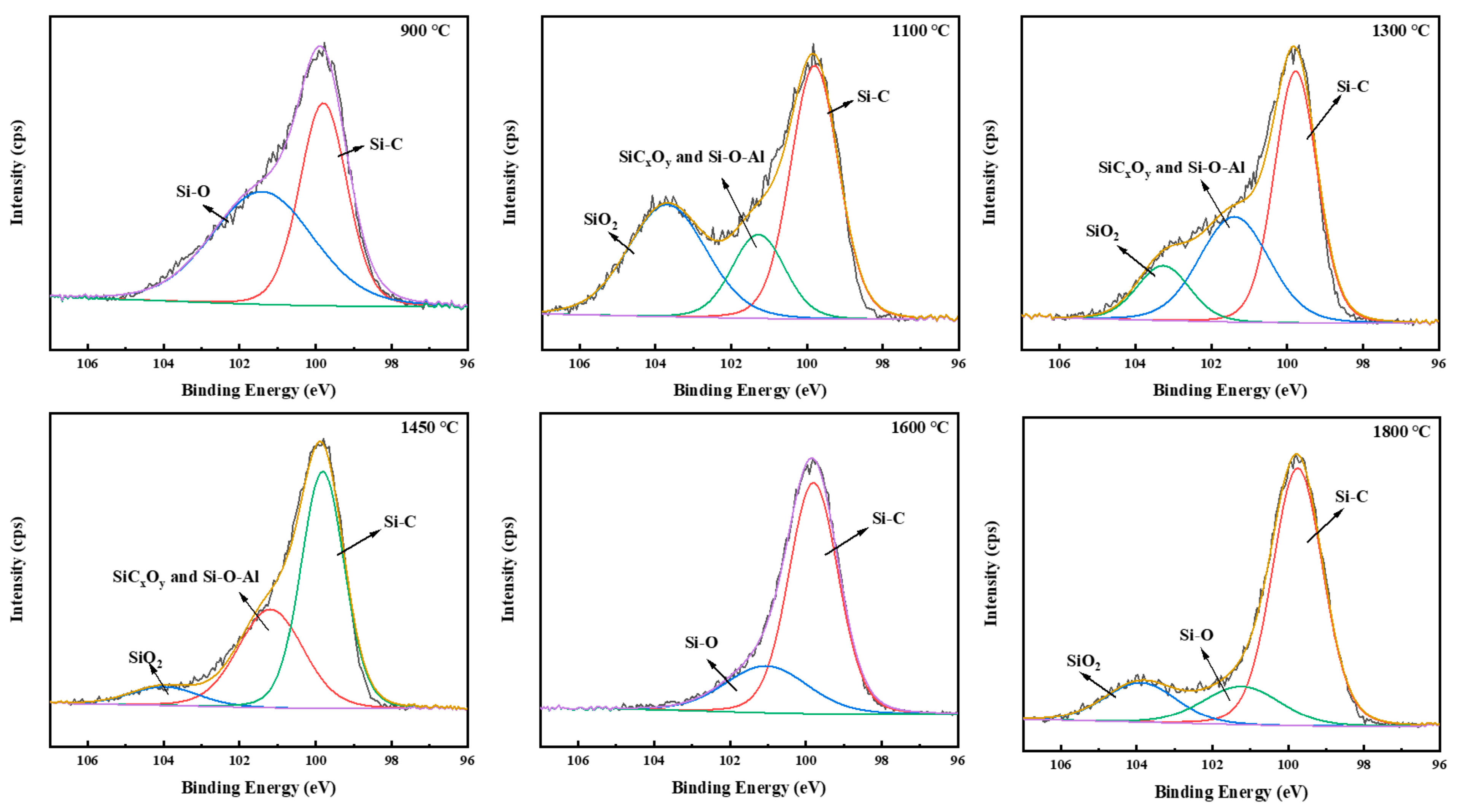
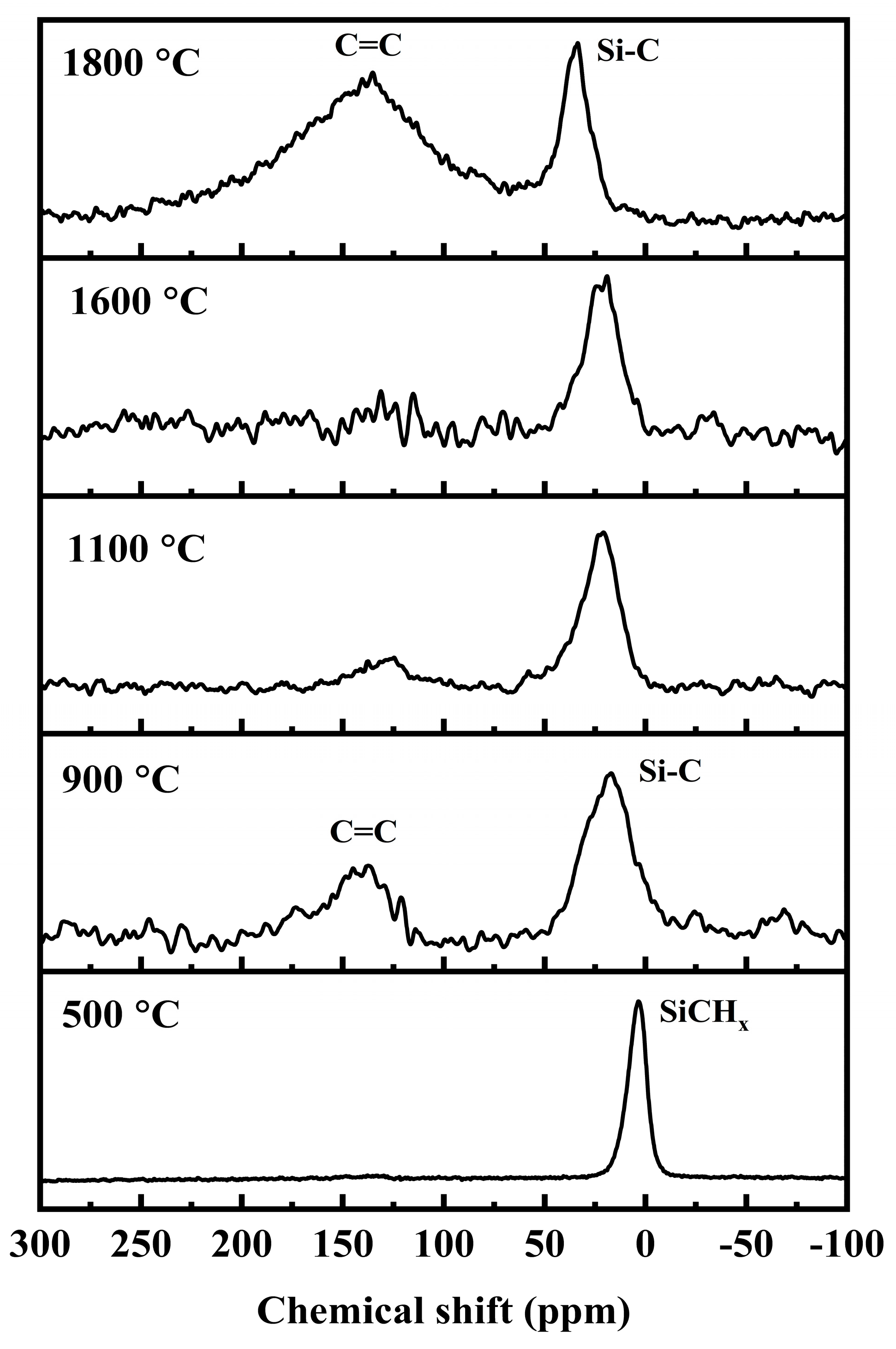
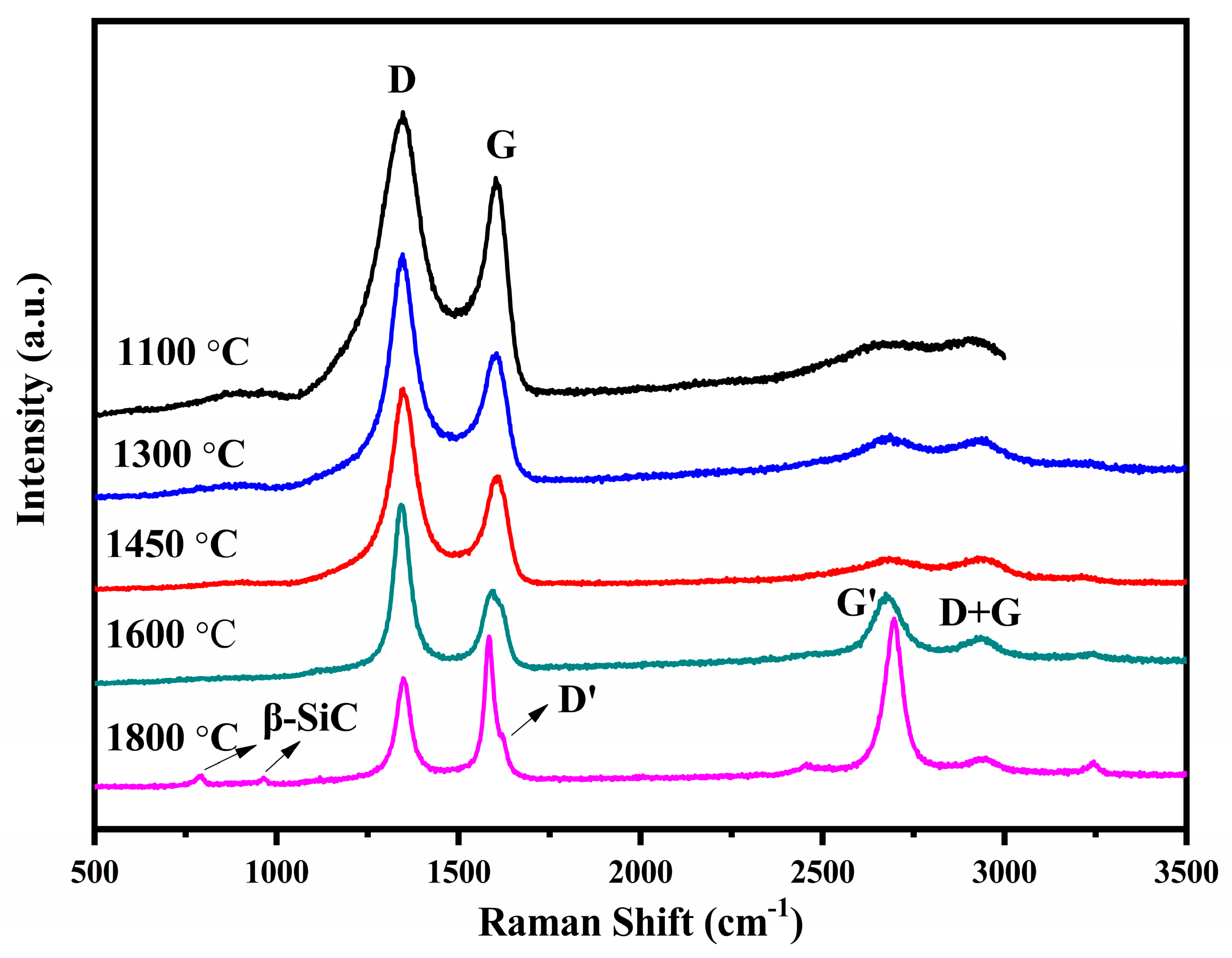

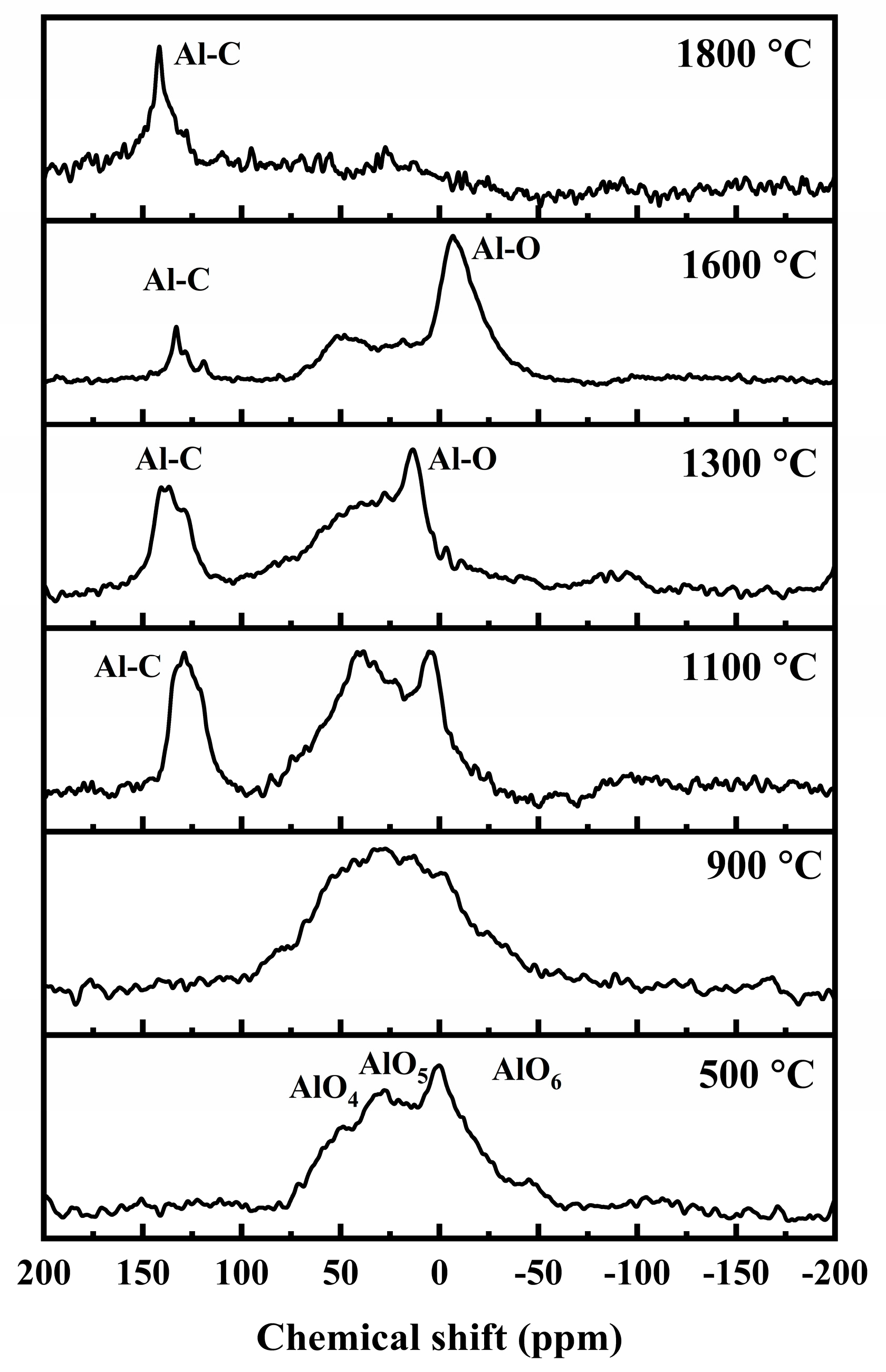
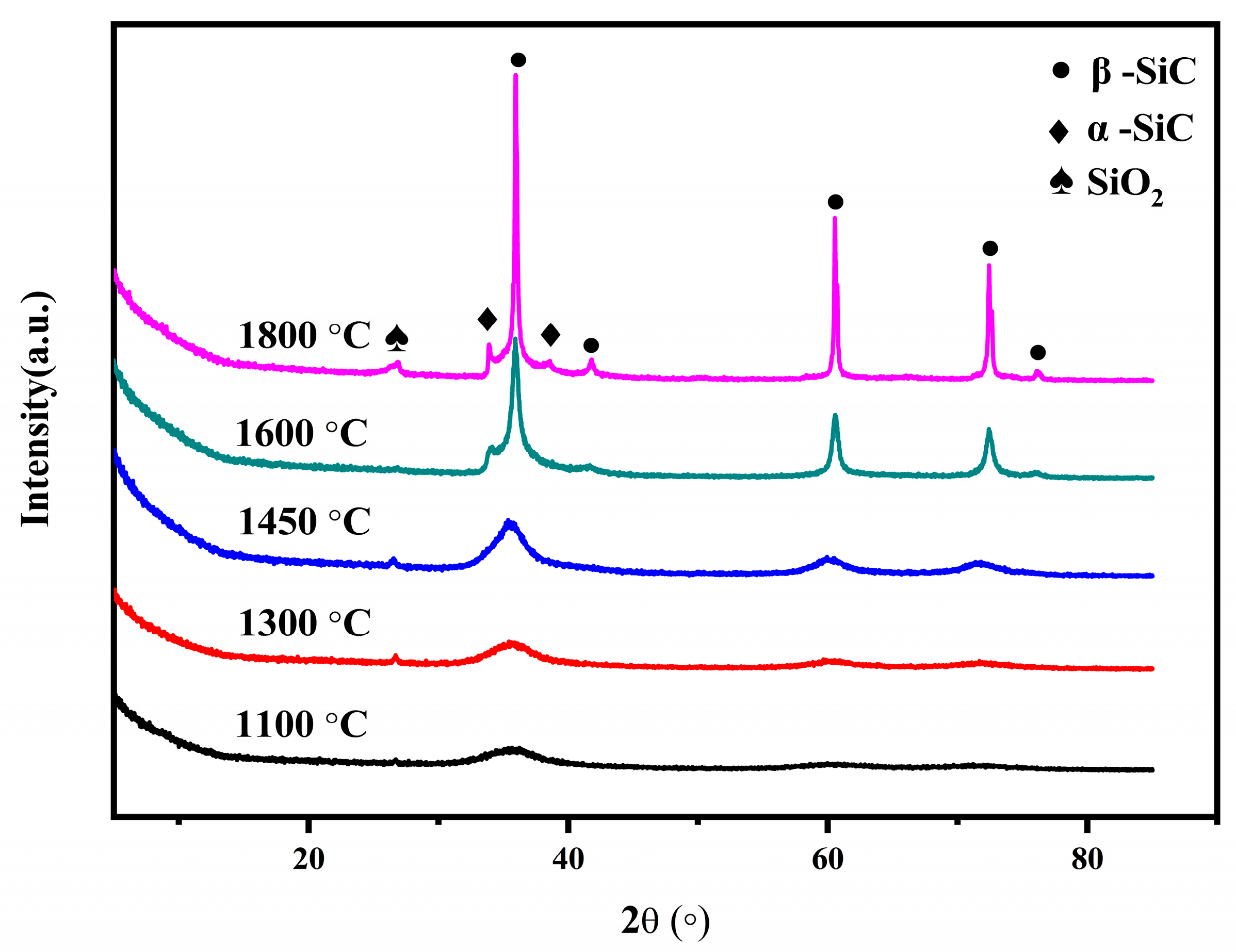
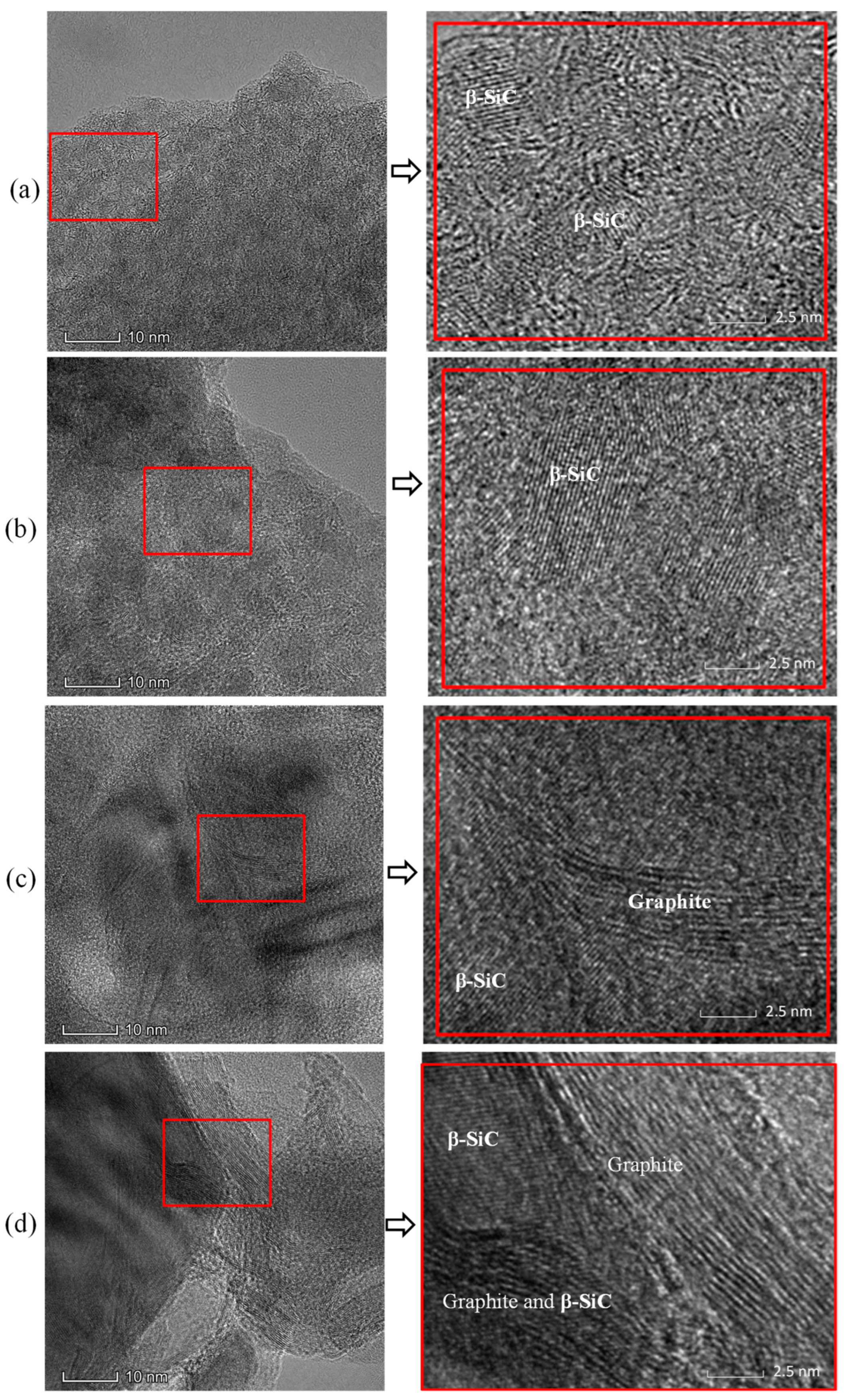
| Sample | Mw | Mn | Mw/Mn | Softening Point (°C) | Al Content (wt%) |
|---|---|---|---|---|---|
| PACS-3 | 3150 | 1079 | 2.92 | 220.7 | 1.24 |
| Sample | G Band Position (cm−1) | ID/IG | La (nm) |
|---|---|---|---|
| PACS-1100 | 1606 | 1.25 | 1.5 |
| PACS-1300 | 1605 | 1.57 | 1.7 |
| PACS-1450 | 1602 | 1.72 | 1.77 |
| PACS-1600 | 1593 | 1.81 | 2.74 |
| PACS-1800 | 1583 | 0.75 | 6.61 |
| Si (wt%) | C (wt%) | O (wt%) | Al (wt%) | nC/nSi | |
|---|---|---|---|---|---|
| PACS | 47.69 | 38.3 | 4.85 | 1.24 | 1.87 |
| PACS-1300 | 55.75 | 34 | 8.24 | 2.01 | 1.42 |
| PACS-1800 | 64.41 | 33.9 | 1.12 | 0.57 | 1.23 |
Disclaimer/Publisher’s Note: The statements, opinions and data contained in all publications are solely those of the individual author(s) and contributor(s) and not of MDPI and/or the editor(s). MDPI and/or the editor(s) disclaim responsibility for any injury to people or property resulting from any ideas, methods, instructions or products referred to in the content. |
© 2023 by the authors. Licensee MDPI, Basel, Switzerland. This article is an open access article distributed under the terms and conditions of the Creative Commons Attribution (CC BY) license (https://creativecommons.org/licenses/by/4.0/).
Share and Cite
Xie, F.; Duan, Y.; Mo, G.; Huang, Q.; Huang, Z. Structural Evolution of Polyaluminocarbosilane during the Polymer–Ceramic Conversion Process. Materials 2023, 16, 4172. https://doi.org/10.3390/ma16114172
Xie F, Duan Y, Mo G, Huang Q, Huang Z. Structural Evolution of Polyaluminocarbosilane during the Polymer–Ceramic Conversion Process. Materials. 2023; 16(11):4172. https://doi.org/10.3390/ma16114172
Chicago/Turabian StyleXie, Fucheng, Yangpeng Duan, Gaoming Mo, Qing Huang, and Zhengren Huang. 2023. "Structural Evolution of Polyaluminocarbosilane during the Polymer–Ceramic Conversion Process" Materials 16, no. 11: 4172. https://doi.org/10.3390/ma16114172
APA StyleXie, F., Duan, Y., Mo, G., Huang, Q., & Huang, Z. (2023). Structural Evolution of Polyaluminocarbosilane during the Polymer–Ceramic Conversion Process. Materials, 16(11), 4172. https://doi.org/10.3390/ma16114172





